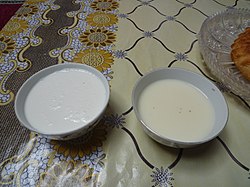

Chal

Alternative names
Shubat
Place of origin
Turkmenistan, Uzbekistan and Kazakhstan
Main ingredients
Chal, also shubatorkhoormog (Kazakh: шұбат, şūbat, pronounced [ʂo̙bɑt], Mongolian: хоормог, khoormog, pronounced [χɔ̙ːrmɞ̙k]), is a Turkic (especially Turkmen, Uzbek and Kazakh) and Mongolic beverage of fermented camel milk, sparkling white with a sour flavor, popular in Central Asia — particularly in Kazakhstan, Uzbekistan and Turkmenistan.[1][2] In Kazakhstan the drink is known as shubat, and is a staple summer food.[3] Due to preparation requirements and perishable nature, chal has proved difficult to export.[4] Agaran (fermented cream) is collected from the surface of chal.[5]
Fermented chal is reputed to possess virucidal and virus inhibiting properties[citation needed] not found in fresh camel or cow milk, both in its liquid and lyophilized form — a characteristic which is (reputedly) unaffected by shelf life.
Chal is typically prepared by first souring camel milk in a skin bag or ceramic jar by adding previously soured milk. For 3–4 days, fresh milk is mixed in; the matured chal will consist of one third to one fifth previously soured milk.[6]
Camel milk will not sour for up to 72 hours at temperatures below 10 °C (50 °F). At 30 °C (86 °F) the milk sours in approximately 8 hours (compared to cow's milk, which sours within 3 hours).
A comparison of the composition of camel milk and camel chal:[7]
Camel milk
“Chal”
acidity
18°D
28°D
fat
4.3%
4.3%
lactose
2.75%
1.32%
non-fat solids
8.2%
6.6%
ash
0.86%
0.75%
ethyl alcohol
1.1%
ascorbic acid
5.6 mg%
4.8 mg%
Dornic acidic degrees are used to describe acidity in milk products, with 1 Dornic degree (1°D) equal to 0.1g of lactic acid per liter.[8] The chal contained Lactobacilli lactic; streptococci and yeast.[9]
Chal may be cultured with lactobacillus casei, streptococcus thermophilus, and lactose-fermenting yeasts incubating in inoculated milk for 8 hours at 25 °C (77 °F), and then subsequently for 16 hours at 20 °C (68 °F). Holder pasteurization does not affect the quality of the milk, but pasteurization at higher temperatures (85 °C/185 °F) for 5 minutes negatively impacts flavour. Chal made from pure cultures of lactobacillus casei, streptococcus thermophilus, and species of torula has markedly less not-fat solids and lactose than the milk from which it is made.[10]
Varieties
Related